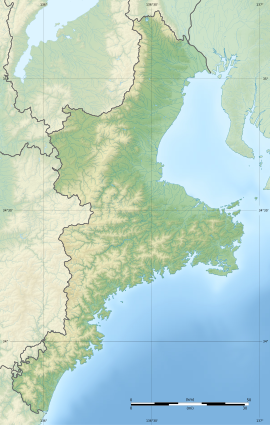Matsusaka Castle
| Matsusaka Castle | |
|---|---|
松阪城 | |
Matsusaka, Mie Prefecture, Japan | |
 portion of the foundations of the Main Keep of Matsusaka Castle | |
| Coordinates | 34°34′33″N 136°31′33″E / 34.57583°N 136.52583°E |
| Type | flatland-style Japanese castle |
| Site information | |
| Open to the public | yes |
| Condition | ruins |
| Site history | |
| Built | 1588 |
| Built by | Gamō Ujisato |
| In use | Edo period |
| Demolished | 1881 |
Matsusaka Castle (松坂城, Matsusaka-jō) was a
Background
Matsusaka Castle is located on the west coast of
The castle itself is built on a wedge-shaped hill facing eastward and consists of three layers of terraces. The Honmaru (central bailey) at the top of the hill is a square and held a three-story five-floor tenshu tower with gold roof tiles on its western side, and a yagura watchtower on its eastern side. The middle enclosure also had a large yagura tower, which overlooked the lowest layer of defenses, which was divided into several smaller kuruwa. The core area of the castle is relatively small, measuring roughly 200 meters square, but unusually for the time, most of the walls on all of the enclosures are faced with stone.
History
During the
In 1590, after the
In 1619, the Furuta clan was transferred to
In 1877, a fire destroyed the palace within the second bailey, and in 1881 all of the remaining castle buildings were pulled down, with the exception of a single rice warehouse.
Present situation
Although few structures now remain of the original castle, the site is open to the public as a park and the stone walls are in good preservation. In 1982, a proposal to reconstruct the tenshu was vetoed due to local opposition. From 1988-2003, the moats and stonework underwent a massive repair and reconstruction process. During this time, it was discovered that much of the stonework was in the same style as Azuchi Castle.
The castle grounds also hold the modern Matsusaka city hall, city hospital, a local history museum and the Motoori Norinaga Memorial Hall.[2] The castle site is a 15-minute walk from Matsusaka Station
The ruins were listed as one of the 100 Fine Castles of Japan by the Japan Castle Foundation in 2006. [3]
Gallery
-
Foundation base for the Tenshu
-
Main Bailey
-
Kitai Enclosure
-
Memorial Stele
-
Rear Gate
-
Official's residence
See also
Literature
- De Lange, William (2021). An Encyclopedia of Japanese Castles. Groningen: Toyo Press. pp. 600 pages. ISBN 978-9492722300.
- Schmorleitz, Morton S. (1974). Castles in Japan. Tokyo: Charles E. Tuttle Co. pp. 144–145. ISBN 0-8048-1102-4.
- Motoo, Hinago (1986). Japanese Castles. Tokyo: Kodansha. p. 200 pages. ISBN 0-87011-766-1.
- Mitchelhill, Jennifer (2004). Castles of the Samurai: Power and Beauty. Tokyo: Kodansha. p. 112 pages. ISBN 4-7700-2954-3.
- Turnbull, Stephen (2003). Japanese Castles 1540-1640. Osprey Publishing. p. 64 pages. ISBN 1-84176-429-9.
External links
Notes
- ^ "松坂城跡". Cultural Heritage Online (in Japanese). Agency for Cultural Affairs. Retrieved 25 December 2016.
- ^ "Japan Mode(JMode.com)". Archived from the original on 2008-05-16. Retrieved 2008-05-23.
- ^ Japan Castle Foundation









